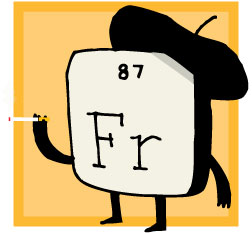Blogging the Periodic Table

When it comes to the periodic table, the United States really blew its chance to make a name for itself. If you look over a map of all the elements named for cities, states, countries, and continents, it's not surprising that European locales dominate the map. Various European countries dominated science itself in the 1700s and 1800s, the centuries when scientists made the greatest progress discovering and naming elements.
View Elements named for places in a larger map
But they didn't discover them all, and there were still plenty of open slots for American chemists to claim by 1900, when the pre-eminence of European science was beginning to decline. America was probably Europe's equal scientifically by the end of World War I, and certainly surpassed it after the chaos of World War II. As one rough measure of this, the Nobel Prizes (which in most cases reward work completed one to two decades before the prize is awarded) began in 1901. In the first four decades, U.S. scientists won 15 prizes; in the next two decades, they won 42.
That's why the U.S. presence on the periodic table seems so meager: Just three elements—americium, berkelium, and californium—are named for locations here. Not that we didn't have our chances. Most residents of the states probably don't realize it today, but U.S. scientists submitted claims for elements named illinium in 1926 and alabamine and virginium in the early 1930s. See this map to get a sense of what might have been:
View States that almost got elements named for them (in yellow) in a larger map
All three claims fell apart under scrutiny, however, and chemists worldwide "impeached" the elements and declined to ratify the names. Some parts of America stubbornly refused to acknowledge this and kept using the names on domestic versions of the periodic table. But soon enough, a French woman named Marguerite Perey discovered the real Element 87 (née virginium) and named it francium. American teams did discover Element 85 (née alabamine) and Element 61 (née illinium) but chose to name them astatine and promethium instead of something more patriotic.
Still, the United States had even more chances. After about 1940, scientists generally stopped looking for elements in nature. Instead, they had to create them, by smashing smaller atoms together. And in the 1950s and '60s, the chemistry department at the University of California–Berkeley emerged as the greatest element-making machine the world has ever known.
Scientists there discovered or co-discovered every element between 93 and 106, extending the periodic table by almost one-sixth. The names americium, berkelium, and californium come straight from their lab.
But instead of honoring other California landmarks—yosemitium or goldengatium—the Berkeley team also started the trend of naming elements after people, beginning with einsteinium, Element 99. This is still the dominant fashion in naming elements, which diminishes the chances of another U.S. city or state joining berkelium and californium on the periodic table. And now that the best U.S. labs for making elements have slipped behind their German and Russian peers, the prospect seems still more remote.
About the only consolation for domestic cartographer-chemists is that the U.S. populace really seems to enjoy naming cities after elements. And not just gold or silver, either. This map shows Barium Springs, N.Ca.; Antimony, Utah; and Lithium, Mo., among other places. (The opportunities for high-school mascots make the mind reel.)
View Places in the U.S. named for elements in a larger map
Sure, most of these towns take their names from local mineral riches, but it's still nice to see the influence of the periodic table in rural America. Takes the sting out of the dominance of European place names on the table itself. At least a little.
Like Slate on Facebook. Follow us on Twitter.